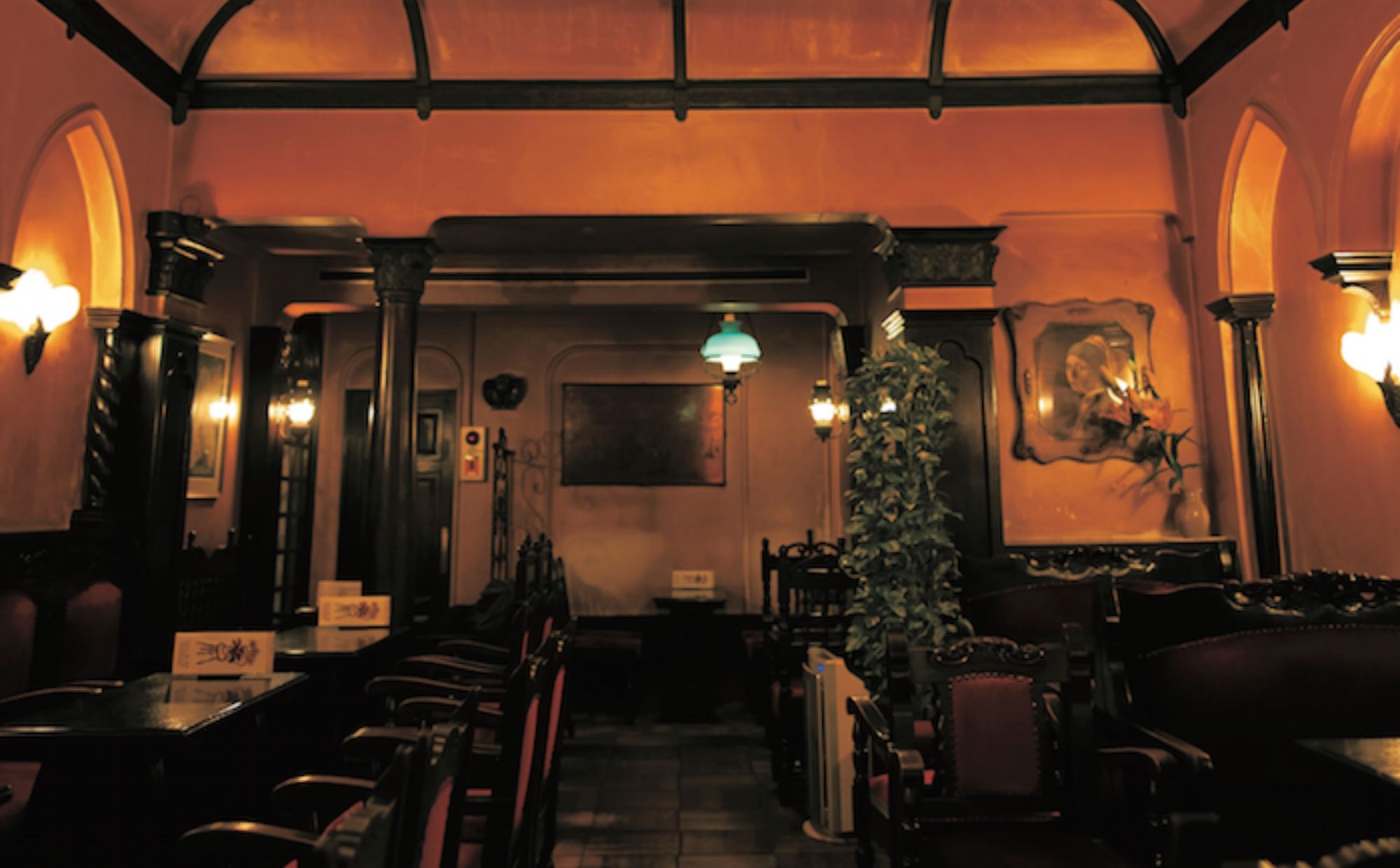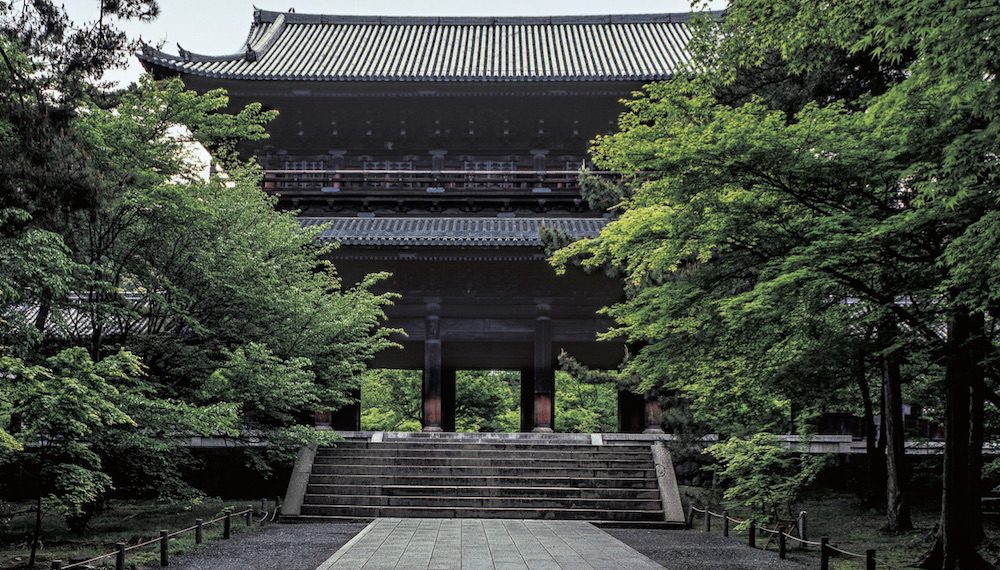‘Chami(茶味)’ (=the heart of tea) is infused in the famous restaurants loved by the locals of Kyoto. Coffee shops, Western-style restaurants, Japanese confectionery shops and bars. Even those visiting for holiday somehow feel at home here. We introduce nine such famous shops and also dive into the secrets of traditional and new shops that are loved by locals.
Kyoto, nine famous restaurants of ‘Chami’
‘Chami’ is the aesthetic sense established in ‘Chano-yu(茶の湯)’, as typified by wabi-sabi. When you visit Kyoto, the hometown of Chano-yu, you will be struck by this sense of chami. A place where you can feel the seasons, a place where you can sense hospitality even in places you can’t see, a place you can create a deepenng bond with. Let us introduce you to nine of the most famous places.
1 Kameyayoshinaga(亀屋良永)
On the left corner of Teramachi Dori, just before it hits Oike Dori. Kameyayoshinaga is a Kyoto sweets shop that offers passers-by a seasonal view of the city. Alongside the famous “Oike Sembei(御池煎餅)”, the window is decorated with “Ohara-ji(大原路)”, a rakugan (落雁) created by Kameyayoshinaga himself. It is a simple design with a circle inside a rectangle, but just by changing the shape and color of the circle, it can be seen as an iris or the autumn moon.
 Dried confectionery made from rakugan, ‘Ohara-ji’, changes its expression nine times a year. This is “Haru no iro(春の色)”, 1,404 yen (incl. tax)
Dried confectionery made from rakugan, ‘Ohara-ji’, changes its expression nine times a year. This is “Haru no iro(春の色)”, 1,404 yen (incl. tax)
Shimomura Takashi, the fifth generation, says:”It is the job of the shop’s owner to think about changing the look of the window and changing the products. It’s sad that not only confectionery shops but also shops with owners that are involved in the day to day operations have become rare.” His son Osamu took over as the sixth generation a few years ago, but the fifth generation also shows up at the shop every day and keeps an eye on things from the ledger.

The word ‘window shopping’ is disappearing, and Kyoto’s shop fronts have changed. That is why theres a feeling that this shop, which continues in the traditional way, is precious.
◆Kameyayoshinaga(亀屋良永)
Address: 504 Shimohonnoujimae-cho, Teramachi-dori Oike-sagaru, Nakagyo-ku, Kyoto
Opening hours: 8am – 6pm
Closed: Sunday, 1st and 3rd Wednesday of the month
Official website
2 Tsujitome Kyoto Honten (辻留本店)
Tsujitome Kyoto Honten, located on Sanjo Ohashi Bridge, specialises in business travel cuisine, serving tea ceremony Urasenke(裏千家) kaiseki (懐石) cuisine. Even tourists can get a taste of this restaurant through their folded lunchboxes.
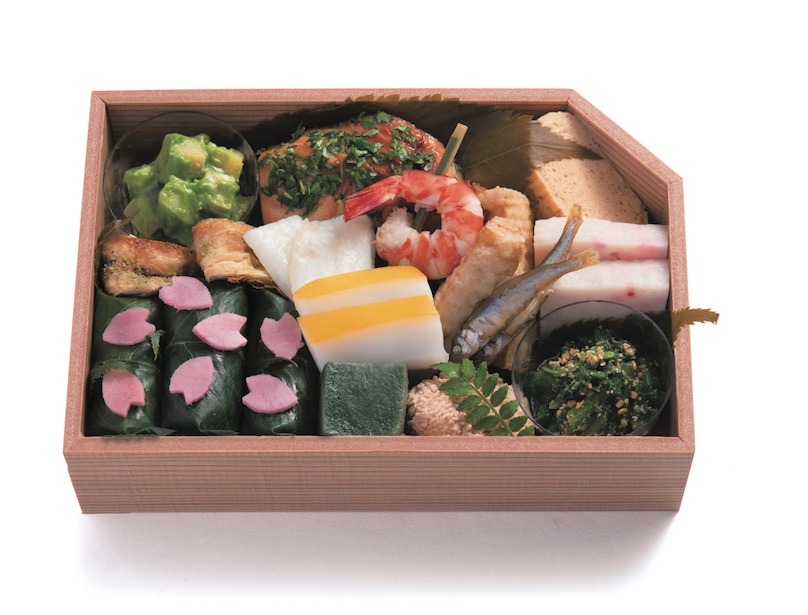 Ashirai petals are pickled ginger. They also serve as a palate cleanser.
Ashirai petals are pickled ginger. They also serve as a palate cleanser.
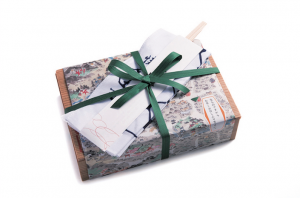 Folded lunch box, 5,000 yen. The map of Kyoto on the broadcast was created by the Japanese painter Ikeda Yoson(池田遙邨). The painting on the lap blanket was by Kitaoji Rosanjin(北大路魯山人), and the string was chosen to represent the colour of tea.
Folded lunch box, 5,000 yen. The map of Kyoto on the broadcast was created by the Japanese painter Ikeda Yoson(池田遙邨). The painting on the lap blanket was by Kitaoji Rosanjin(北大路魯山人), and the string was chosen to represent the colour of tea.
“Twenty years ago, when we first served this bento, the price of 5,000 yen was outstandingly high. Even so, we never changed our mindset of always packing good food and making the folded box with care and attention to detail”, says the owner, Taira Haruhiko, who designed the bento boxes.
These bentos follow the basics of kaiseki, such as using ingredients that are at their best at the time of year and arranging them in a way that makes them easy to eat. As well as standard items such as sushi (spring: sea bream and cherry leaf sushi =鯛桜葉巻寿司) and dashimaki tamago, there are also plenty of seasonal flavours to choose from.
◆Tsujitome Kyoto Honten (辻留本店)
Address: 3-cho, Sanjo Ohashi Higashi, Higashiyama-ku, Kyoto
Opening hours: 9am-6pm
Closed: Open daily
Advance booking is required for folded lunchboxes, which can also be picked up at the head office. Also available at the long-established bento shop in JR Kyoto Isetan (京都伊勢丹) B2, or at Maiko(舞妓) in the Shinkansen ticket gate on the 2nd floor of JR Kyoto Station.
Official website
3 Yosyoku-no-mise Mishina
The hand craftsmanship and elegant atmosphere. Yosyoku-no-mise Misina, where you can enjoy Western-style cuisine with a difference, is located in an alley halfway up Nineizaka(二寧坂), near Kiyomizu-dera Temple.
The restaurant has counter seating only, with Mishina Masako (mother) and Takako (eldest daughter) in front of the open kitchen, and Takashi (eldest son) standing by at the gas burner. The restaurant was started by a couple, but over the years it is now run by a mother, son and daughter team.
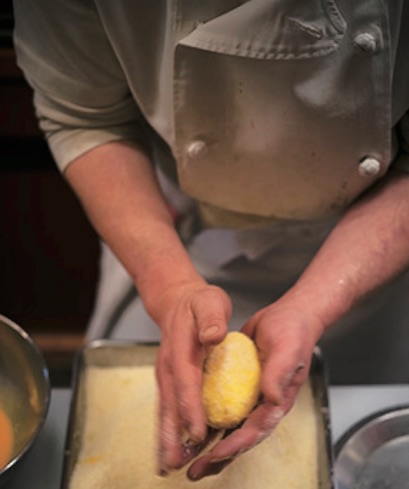
“Each of us has our own role. Working with a sense of ownership is important, even within a family”, says Masako. The warmth of a family-run restaurant yet added with an appropriate level of proffesionalism. That is the beauty of this shop.
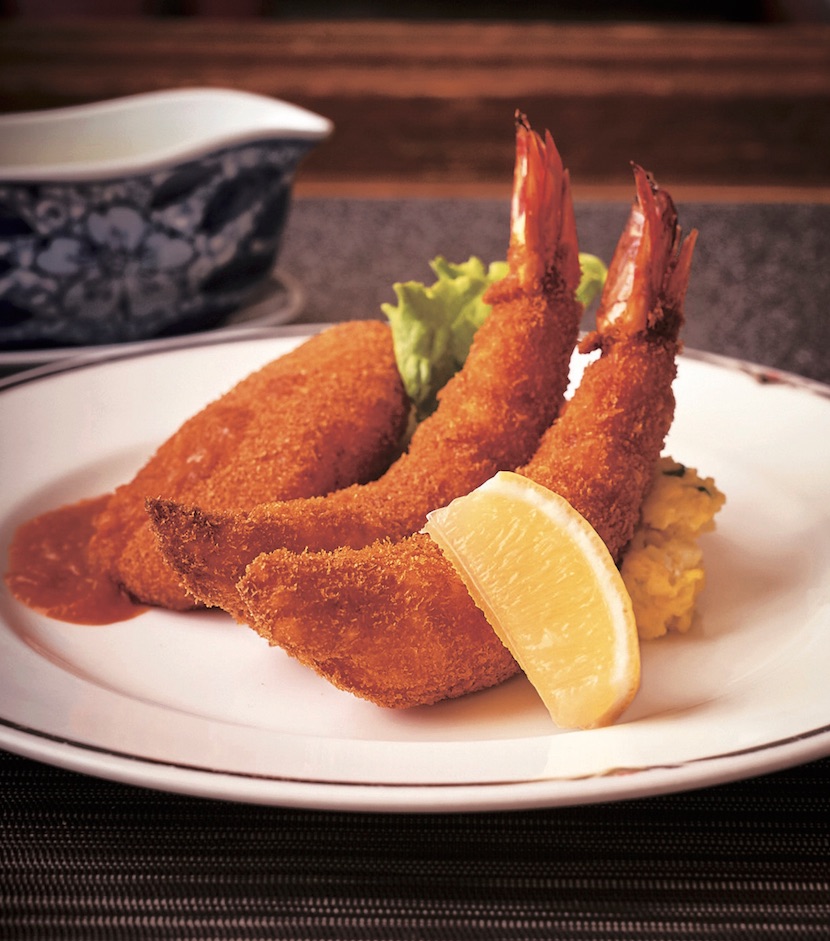 Lunch dish. Assorted crab cream croquettes and fried prawns with ochazuke, JPY 2,700 (incl. tax). Also refined taste of ochazuke at the end of the meal!
Lunch dish. Assorted crab cream croquettes and fried prawns with ochazuke, JPY 2,700 (incl. tax). Also refined taste of ochazuke at the end of the meal!
Masako-san’s family home used to be a high-end Western-style restaurant called Tsubosaka in Gion. Its menu is also served here. As can be seen from the batter for their fried foods, the recipe is exceptional!
◆Yosyoku-no-mise Mishina
Address: 357 Masuya-cho, Higashiyama-ku, Kyoto
Opening hours: 12pm – 2.30pm (L.O.) 5pm – 7.30pm (L.O.)
Closed: Wednesdays, 1st and 3rd Thursdays (or the following day if the day falls on a public holiday)
Reservations not possible for lunch; required for dinner.
Kyo-no-saka-michi Ichinenzaka and Ninenzaka official website
4 Syuto Yanagino (酒陶 桺野)
’Shuto Yanagino’ was born from a combination of a bar and a space with clay walls, solid wood and a single flower, which started, about 20 years ago as a small room that could at the time, only seat four people.
“The shop was created with the help of Tsukuda Tatsuo, who runs the ‘Kobijyutu Tsukuda’ shop, after I started an apprenticeship with him when I was a university student. According to Tsukuda’s aesthetic sense, the tea room is the best space. I like drinking, so it became a tearoom bar”, says Yanagino Hironari. After two relocations, the restaurant has settled into its current space of 10 counter seats and one table.
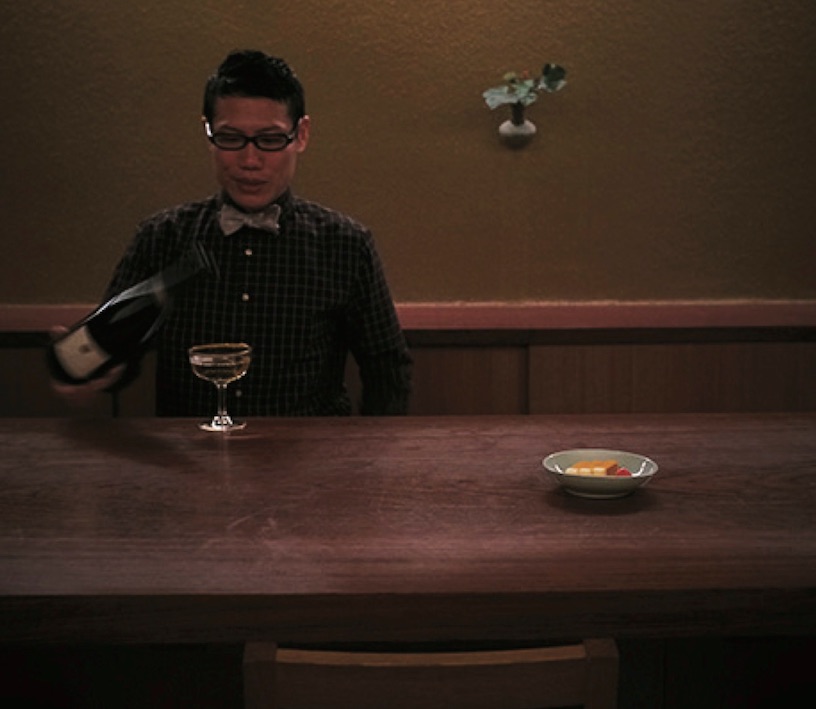 The term ‘Shuto’ was coined to describe the shop’s background, which began with a love of sake and antiques. The plate for the ‘Carrot Paté’ in the foreground, on the right-hand side of the image, is Kyohakuji(京白磁) from the end of the Ming dynasty. It is only here that conversations at the bar begin with the plates.
The term ‘Shuto’ was coined to describe the shop’s background, which began with a love of sake and antiques. The plate for the ‘Carrot Paté’ in the foreground, on the right-hand side of the image, is Kyohakuji(京白磁) from the end of the Ming dynasty. It is only here that conversations at the bar begin with the plates.
The food menu is different from typical bar food. The owner’s handwritten items on the letterhead are a joy to read, just like a seasonal letter.
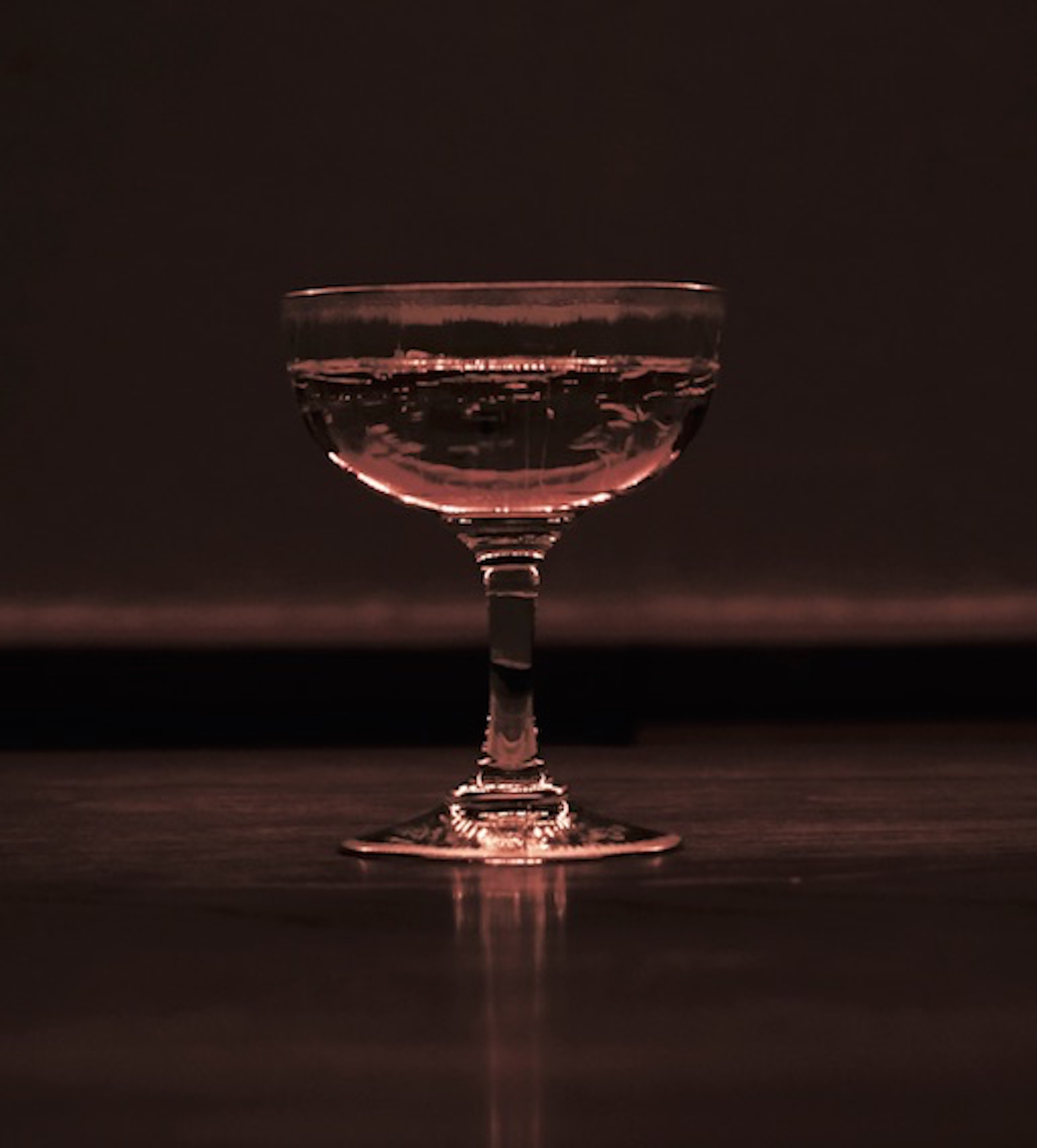 The Champagne glass made by Dome around 1900
The Champagne glass made by Dome around 1900
“I would be happy to have people who enjoy playing catch across the counter. We want to fulfill their expectations but also exceed them”, says Yanagino.
◆Syuto Yanagino (酒陶 桺野)
Address: Shinmachi Nishiiru, Sanjo-Dori, Nakagyo-ku, Kyoto
Opening hours: 18:00 – 26:00
Closed: Thursday
Charges: JPY 500, cocktails from JPY 900. From JPY 8,000 per person for a cooking course with advance reservation required
5 Aritsugu Nishikiten(有次 錦店)
Kyoto is a treasure house of handicrafts. The descendants of craftsmen who have been making things since the time of the capital are still here..! Aritsugu, founded in 1560, is a representative of these craftsmen, with a long background in swordsmithing and small knives for carving Buddhist statues. The company’s mainstay kitchen knives and cooking utensils, which it began to produce around the end of the Meiji period, are made with great care and attention to detail, while maintaining the quality that it has maintained since its founding.
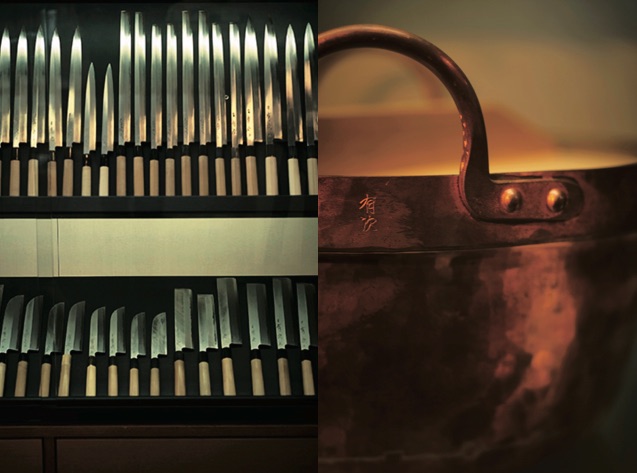 左Left: Aritsugu knives have excellent sharpness and a refined design with no unnecessary decoration. Small knives for sharpening tea scoops are popular with people in the tea industry.
左Left: Aritsugu knives have excellent sharpness and a refined design with no unnecessary decoration. Small knives for sharpening tea scoops are popular with people in the tea industry.
Right: Aritsugu pots and pans are favoured by professional cooks. They are sturdily built, but also well equipped with a repair system to ensure long use.
 Cutters made from brass to give a delicate look; more than 150 types available, starting from JPY 1,000 for a small cutter.
Cutters made from brass to give a delicate look; more than 150 types available, starting from JPY 1,000 for a small cutter.
As not many can be made in a day, new products are rarely introduced. However, at the end of the year, cutters of the following year’s zodiac signs are placed in the front row, giving the shop a seasonal feel.
◆Aritsugu Nishikiten(有次 錦店)
Address: 219 Kajiya-cho, Nishiki-koji Gokomachi Nishiiru, Nakagyo-ku, Kyoto
Opening hours: 9am – 5.30pm
Closed: 1-3 Jan.
Nishiki Market Shopping Arcade Official website
6 Kyoto no Hanaya Mitate
In a corner of Kita-ku, Kyoto, lies the atmospheric flower shop ‘Mitate’. A one-of-a-kind world view is created by the way the vases look, that bring the plants and flowers in the alley, to life.
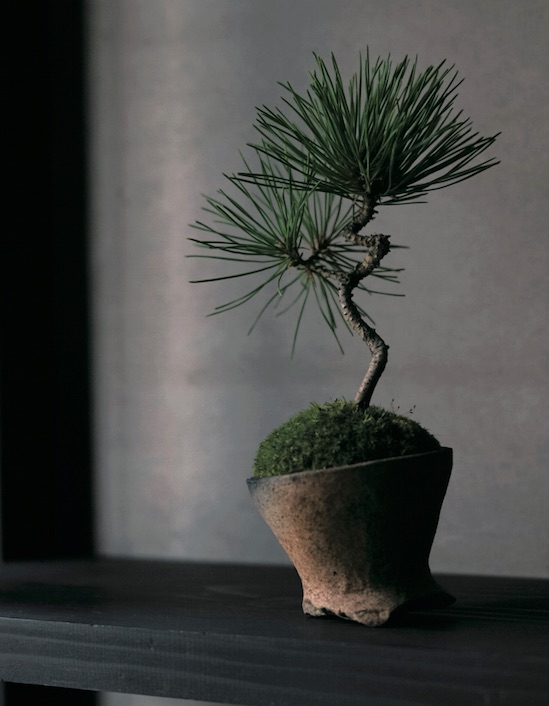
A black pine and Yayoi earthenware vase costs around JPY 10,000, which is the approximate budget. The shop is lined with wild flowers and branches that bloom in the season.
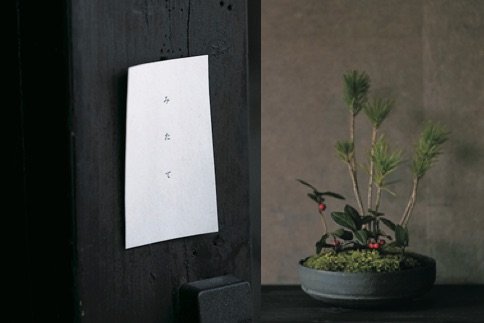 “When you go to a temple and look down at your feet, you are struck by the casual combination of the tree and the leaf orchid. I cherish those memories.” says shop owner Nishiyama.
“When you go to a temple and look down at your feet, you are struck by the casual combination of the tree and the leaf orchid. I cherish those memories.” says shop owner Nishiyama.
There are other shops specialising in Japanese flowers and wildflowers, but what sets Mitate apart is the ability to match them with objects that could be used as vases. For example, the black pine tree above is a piece of Yayoi earthenware, and sometimes a saggar, a potter’s tool used when firing ceramics, can be used as a vase.
The shop opened in 2013. The attempt to present the seasons in their original form is breathing new life into the town.
◆Mitate
Address: 41, Shitake-Shita-Takedono-cho, Kita-ku, Kyoto
Opening hours: Fri-Sat 12pm-5pm
Closed: Mon, Tue, Wed, Thu, Sun
Official website
7 Sanadahimoshi Enami(真田紐師 江南)
‘Sanadahimoshi Enami’ is located 15 minutes’ walk from Shijo-Kawaramachi(四条河原町). Sanadahimo was made to tie up heavy items such as armour and heavy objects, and is ‘strong without stretching’. Sen no Rikyu(千利休) started hanging these cords on paulownia boxes used to hold tea utensils.
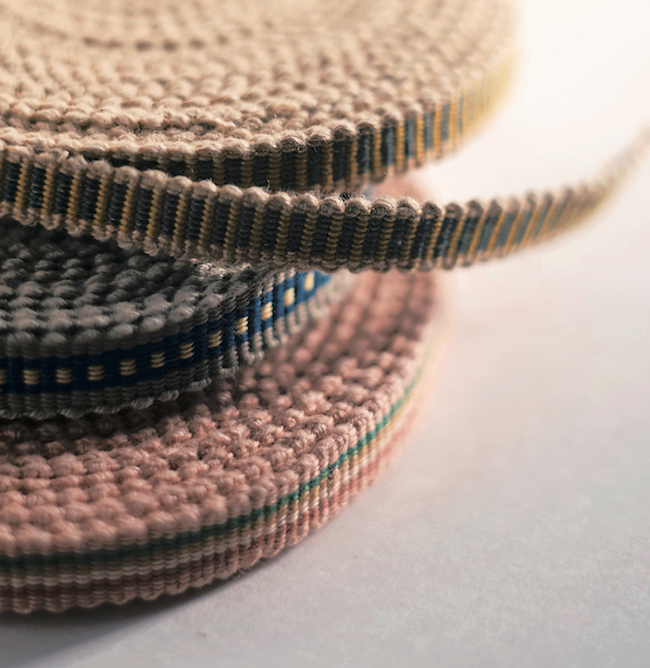 Kusakizome teori Sanadahimo(草木染手織真田紐), available in widths from 2′ (6 mm) to 1’7″ (5 cm), 1 m JPY1,500-JPY4,500.
Kusakizome teori Sanadahimo(草木染手織真田紐), available in widths from 2′ (6 mm) to 1’7″ (5 cm), 1 m JPY1,500-JPY4,500.
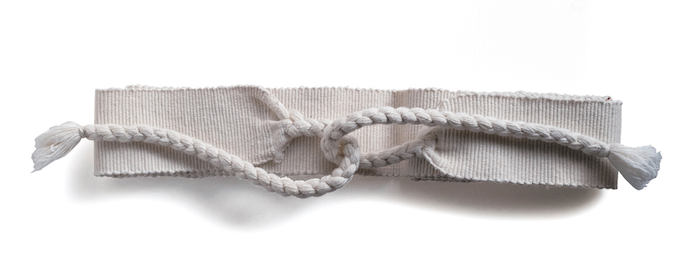 Koshihimo(腰紐) (white) JPY 5,000.
Koshihimo(腰紐) (white) JPY 5,000.
“The thick lines on the cord pattern are meant to indicate ‘be careful of heavy objects’, as expected,” says Wada Isao, the 15th owner of the shop. Before the Taisho era, Sanadahimo used for tea ceremony utensils was mainly made of cotton dyed with plants and trees, but Mr and Mrs Wada produce hand-dyed and hand-woven Sanadahimo in the same way. The charm of this shop is that you can enjoy conversation about everything from hobbies, such as arranging cords in a fashionable way, to tea ceremony utensils.
◆Sanadahimoshi Enami(真田紐師 江南)
Address: 430, Gojo-shitaeru, Toiyamachi-Dori, Higashiyama-ku, Kyoto
Opening hours: 10am – 5pm
Closed: Wednesday
Official website
8 Kaikado(開化堂)
‘Kaikado’ continues to produce tea caddies that can be used even after 100 years. The tin tea caddies from the time of the company’s founding (early Meiji era), which are displayed in a prominent place in the shop, can still be opened and closed and are still airtight..!
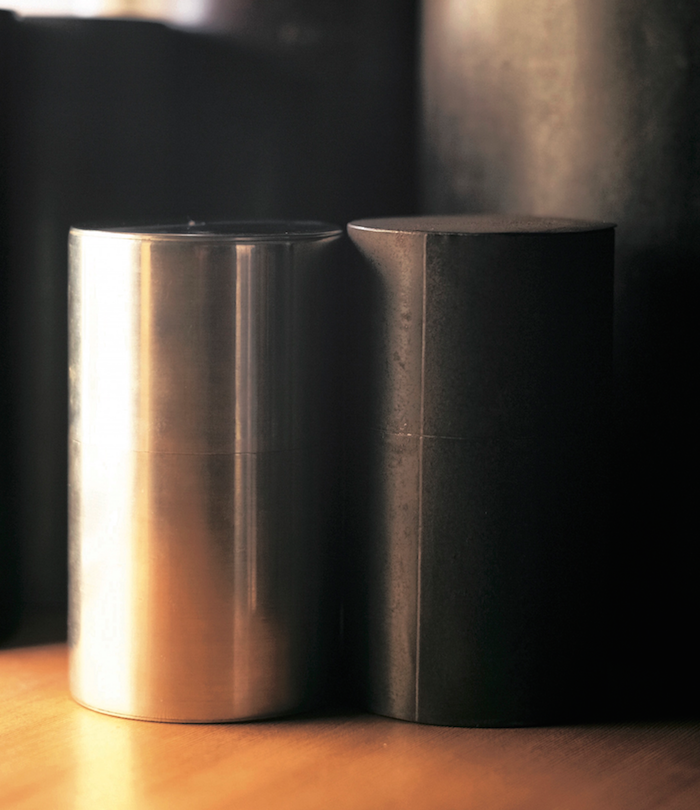 Tea caddies are available in tinplate, steel and brass (Shinchu), with a colour change over time. New tin canister JPY 10,000 (100 g).
Tea caddies are available in tinplate, steel and brass (Shinchu), with a colour change over time. New tin canister JPY 10,000 (100 g).
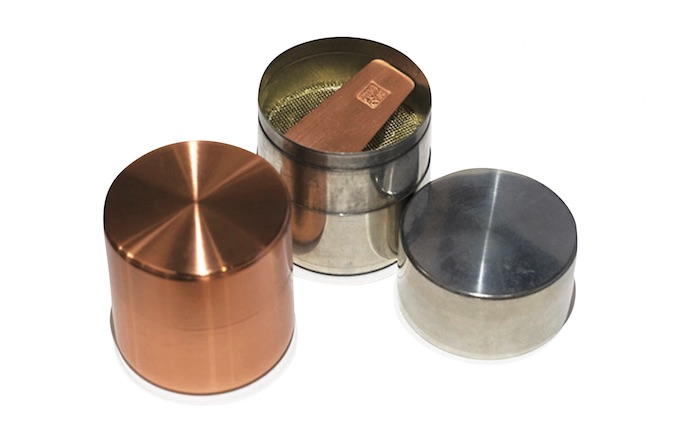 Set of copper tea caddies for matcha (40 g) with tin sieve net (with portable purse, spatula and tea spoon), JPY 1,400.
Set of copper tea caddies for matcha (40 g) with tin sieve net (with portable purse, spatula and tea spoon), JPY 1,400.
“In my grandfather’s generation, we made tea canisters with sieve nets for powdered green tea, and in my father’s generation we added portable tea canisters. I was happy to be able to make coffee cans in my generation,” says Yagi Ryusuke, the sixth generation.
“I want to make something that I can pass onto the next generation in my generation” is a phrase often heard in Kyoto’s long-established shops, and in good shops, this is thrown clearly in the way they are run.
◆Kaikado(開化堂)
Address: Kawaramachi Rokujo Higashiiru, Shimogyo-ku, Kyoto
Opening hours: 9am-6pm
Closed: 2nd Monday, Sunday and public holidays
Official website
9 Francois Kissasistu(フランソア喫茶室)
The Francois Kissasistu takes its name from the painter ‘Francois Millet’. Founded in 1934 and inspired by the halls on board a luxury Italian Baroque cruise liner, this is Japan’s first coffee shop registered as a cultural asset.
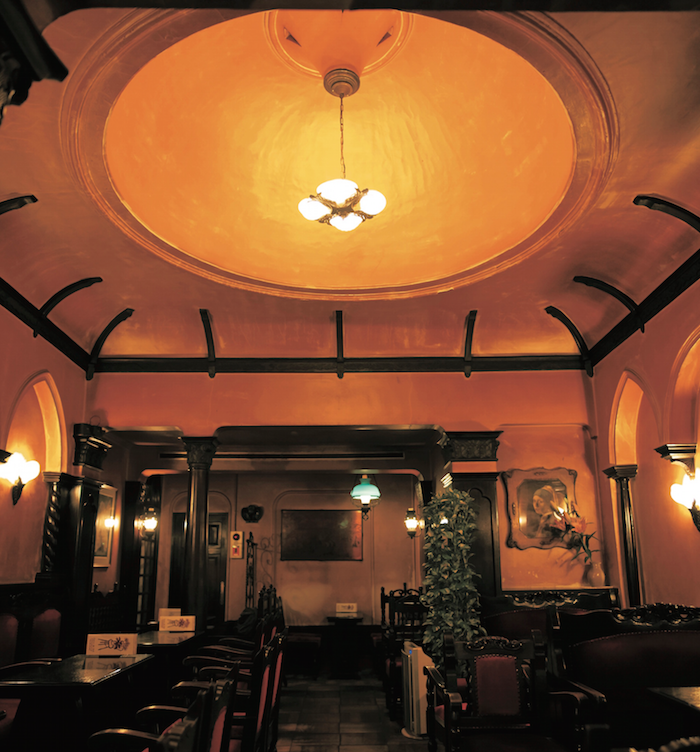
From the time the shop opens at 10am, it already has a classy vibe. The majestic baroque music fills the room and encompasses your whole body.
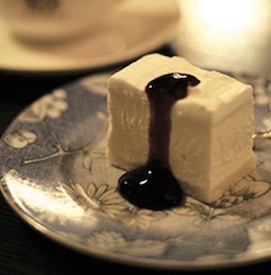
The most popular item is the cake, but the sandwiches and toasts are also perfectly prepared and taste excellent. The accompanying salads also have lovely toppings. The coffee is made by a flannel drip, and the delicious taste that comes from everything being handmade, is what makes this place so special.
What is also charming about Francois Kissashitsu, is that despite its long history, its not boastful of this. They also have prepared 234 tracks in order to be able to change the music on request, which adds an unfathomable charm to their background music.
◆Francois Kissasistu(フランソア喫茶室)
Address: 184 Funato-cho, Nishikiyacho Shijo Shimogyo-ku, Kyoto
Opening hours: 10am – 10.30pm
Meals 21:30pm L.O. Drinks and cakes 22:15pm L.O.
Closed: Year-end and New Year holidays
Official website
This article is translated from https://intojapanwaraku.com/rock/travel-rock/7601/






